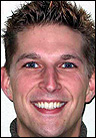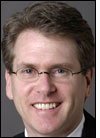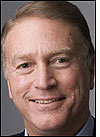A surge in item-level tagging in the retail apparel industry has fueled an unprecedented growth in sales of RFID passive ultrahigh-frequency (UHF) EPC Gen 2 (ISO 18000-6C) integrated circuits (ICs), inlays and tags over the past few months. Chip and tag vendors report that while EPC Gen 2 passive RFID tag growth in such sectors as aerospace and defense, transportation and manufacturing has been more moderate, a recent uptick in the tagging of apparel and other items by retailers has increased the quantity and size of orders. In fact, according to Michael J. Liard, the director of ABI Research‘s RFID practice, this year’s UHF IC sales volume is expected to exceed one billion units. (The consultancy declines to divulge its market forecast in terms of dollars.)
In 2010, the worldwide market for UHF Gen 2 chips, also known as integrated circuits, rose by more than 200 percent from the year prior, following tepid sales for 2008 to 2009, during the economic recession. Next year, however, growth in chip sales is expected to continue sharply upward, by about 65 percent. For RFID transponders (tags and inlays), the growth rate was at 125 percent for 2009 to 2010, and is expected to be 105 percent for 2010 to 2011. For both chips and transponders, Liard says, the majority of that growth is being powered by purchases in the apparel industry.
“There’s been tremendous growth on the IC side,” Liard states. Fueling the increased chip orders, he says, is the demand for RFID tag inlays. “The inlay folks are at full tilt. On the user side, the demand is very high… This is growth we’ve never seen before.”
The rise in tag sales is being driven by what Liard calls explosive growth in retail tagging—that is, tagging individual items, such as garments. Wal-Mart Stores plays a significant role in that growth, he notes, but in addition, “lots of big powerful retailers are stepping in,” applying RFID tags to some of their clothing lines, all of which is being closely watched by apparel makers, who may ultimately take on the responsibility of tagging items at the point of manufacture.
At the same time, shipments of high-frequency (HF) 13.56 MHz passive RFID chips is expected to increase between 2009 and 2014, at the less vigorous pace of 16 percent compounded annual growth rate. Passive HF tags are typically used in such applications as access control, library management and, in many instances, ski-lift tickets. “If current demand for passive UHF in apparel, in particular, holds, and anticipated RFPs [requests for proposal] from additional retailers are realized and fulfilled,” Liard says, “it is possible that passive UHF IC production, on an annual basis, could begin to outpace HF by 2013 or 2014.”Recent sales reports from Alien Technology, which manufactures EPC Gen 2 RFID chips, inlays and readers, seem to confirm Liard’s supposition. “The first part of 2009 was a difficult period,” says George Everhart, Alien’s CEO. That began to change in the second half of the year, he says, though it had been unclear whether that growth was simply a correction following the reduction in orders resulting from the recession. The company’s fiscal year 2010, however, was at an all-time high, he says, adding, “we have sustained that level of growth each quarter.” When it comes to predictions of future sales, he notes, “All of our business [tags, chips and readers] is so robust, we are forecasting based on capacity.”
For the past six months, in fact, the RFID hardware industry has seen demand outpacing supply, which has led to some order-fulfillment delays (see RFID Hardware Supply Struggles to Meet Demand). Consequently, vendors indicate they have developed strategies to address that demand by increasing capacity, though neither Alien Technology nor RFID chip maker Impinj would comment on the details, citing competitive reasons.
“We have a decent view of what’s going on in the market, and we find apparel tagging is the big driver,” says Bill Colleran, Impinj’s CEO. If the tagging of apparel continues on the path it is currently taking, he says, the growth in sales of EPC Gen 2 UHF tags can be expected to be unprecedented over the next few years. A big part of the tag industry’s growth is being driven by Wal-Mart’s recent efforts to get some of its suppliers of denim products and basics to tag goods at the point of manufacture (see Wal-Mart Relaunches EPC RFID Effort, Starting With Men’s Jeans and Basics). He notes, however, that if Wal-Mart and other retailers begin tagging all of their products, the number of tags will rise even more dramatically. The market is preparing for such growth, he reports, with consumer goods manufacturers showing an interest by piloting RFID systems—and, in some cases, installing permanent RFID infrastructure for tagging product at their factories. That, Colleran points out, will reduce the cost of tagging items for the retailer.
“About six months ago,” Colleran states, “we started seeing a dramatic change in the landscape (of RFID IC sales), and it was still unclear if this was just recovery.” Still, he observes, the surge has continued—for the second half of 2010, Impinj’s chip sales equaled the sales total for the previous five years. The company expects 100 percent growth in sales next year, compared with those in 2010. “If, two years from now, every item of clothing you buy has a tag on it,” he says, “I wouldn’t be surprised.”
In fact, Colleran adds, if tags do become ubiquitous within the next few years, it would provide an ecosystem in which retailers can begin exploring other uses for those tags, such as using them for electronic article surveillance (EAS) systems, or at the point of sale. That could lead to more specialty tags with greater functionality, such as those with higher memory to store more data, or security options.According to Alien’s Everhart, the demand for RFID chips and inlays is just as strong in sectors other than retailing. That includes tags for tracking assets such as cattle, as well as employee ID badges, RFID-enabled ticketing and anti-counterfeit tags. “In the last week, we’ve seen tens of millions of units ordered, and none were in apparel,” he says. Included in that number are chips used in the inlays Alien produces, as well as those it sells to other tag manufacturers. “The first week of this quarter, over half of the entire quarter’s forecasted [sales] have already been ordered.”
The growth is not focused on one geographic area, Everhart notes, but rather is spread evenly across the globe (though initially, the majority of sales were achieved within the United States). “Right now, I would not be surprised if growth outpaced even some of the optimistic predictions,” he states. “What will determine that growth is capacity, not demand,” and the challenge for RFID tag vendors is to ensure that product quality is not compromised with that increase in capacity.
RFID tag and label maker Avery Dennison is enjoying a similar sales spike. In a Sept. 23 news article, the company’s chairman and chief executive, Dean Scarborough, told Dow Jones Newswires that Avery Dennison is currently in discussions with nearly two dozen other retailers regarding RFID, though he declined to identify those companies until their plans become more definite. The firm’s RFID revenue, the article reports, “is estimated at $50 million this year, possibly increasing to $150 million in 2011. Some analysts predict the company’s RFID revenue will eventually reach $500 million to $1 billion a year. Avery’s net sales last year were $5.95 billion.”
According to Jack Farrell, VP and general manager for Avery Dennison’s RFID division, sales this year are more than double what they were in 2009, and he expects that growth to continue, with more than twice the sales total in 2011, compared with 2010. Avery Dennison was prepared for this growth, since it had predicted the current surge in sales, Farrell says.
“We’ve been working very, very closely with global retailers, and so we saw the demand building,” Farrell says. “For that reason we were able to anticipate some of this growth.” To meet the demand, he says, Avery Dennison has invested in new production equipment, as well as offering a larger choice of RFID tag products specific for the vertical markets in which they would be used. Still, he adds, the high demand for chips has meant delays of ICs for the company. Farrell expects chip manufacturers’ supplies to catch up with demand by the first quarter of 2011.
Currently, Liard says, the greatest growth is still in sales of simple EPC tags, but in the future, he predicts, there may be a need for tags with higher memory. “The applications will dictate that,” he says. ABI Research has felt the increased interest in RFID, with a greater amount of traffic to its Web site. “That,” Liard speculates, “is being driven, in part, by apparel.”
Sami Nassar, the director of product marketing and business development at NXP Semiconductors, a manufacturer of HF and UHF RFID chips, is also forecasting greater demand for specialized EPC Gen 2 chips with added memory or security. That trend, he predicts, will be driven by companies seeking to prevent counterfeit goods from reaching the market. “Brand protection requires authentication that, in turn, require more sophisticated security algorithms,” he states. “A wide range of industries, ranging from vodka and wine to fashion goods, are more concerned today about counterfeit products.” What’s more, he says, “We are seeing more applications requesting larger product-related information to be stored on the chip.”




